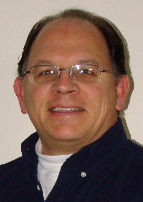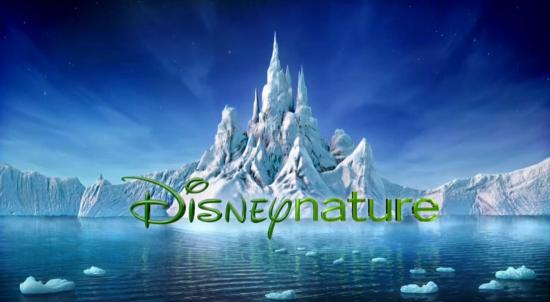As early as 1942, Walt Disney had considered the possibilities of making a live action nature film. He had gone so far as to engage in discussions with the New York Zoological Society in 1944. At this time, the Walt Disney Studio was occupied by the military, and commercial film production had given way to making military training films. With war raging, the nature film became one of many of Walt’s dreams that were put on hold for the duration.
On Saturday, February 25th, Don Hahn, producer of such acclaimed Disney features as Beauty and the Beast and The Lion King, treated the audience in The Walt Disney Family Museum theater to a visually dazzling, and sometimes hilarious, behind the scenes look at the history of Walt Disney’s True-Life Adventure films. This highly-popular, award-winning series was the precursor to the current series of nature films produced under the Disneynature brand.
Volunteer Frank Teurlay with Don Hahn
The first True-Life Adventure, Seal Island, came about as a result of viewing a vast amount of film footage shot in Alaska while filming a story about Inuit people. There was enough footage of the Alaskan wildlife that a nature film emerged. As Walt Disney attempted to sell the film, Disney's film distributor, RKO, argued that no one would pay to see such a film. This rejection eventually led Walt and Roy Disney to create the Buena Vista Distribution Company so that the Walt Disney Studios could control its own film distribution. With no distributor for the film, Walt arranged for Seal Island to play for one week at a theater in Pasadena. The film then qualified for Academy Award® consideration and was awarded the Oscar® for best short subject in 1949.
The few "nature films" made up to that time tended to focus on showing the human dominance over wild creatures. These pseudo-documentaries did not show life from the perspective of the animal. Rather, the animals were, sometimes, mistreated objects used to further a human conquest story. Seal Island ushered in a new type of wildlife film; one based on an interesting story as experienced by the animals in their own natural environment. The True-Life Adventure films boasted that the action was pure “unrehearsed” and “unbelievable” adventure. Audiences embraced the new form of entertainment. It brought to life a beautiful and exciting natural world filmed in locations that had been seen by very few in the days before television.
While the True-Life Adventures were exciting to watch, few realized the painstaking efforts that were required to capture good film footage of wild animals in their natural habitat. Don pointed out many of the difficulties faced by the wildlife filmmakers of the day. To capture nature in its raw form, filmmakers went out into the wild for long periods of time far from civilization. They battled insects, weather and sometimes exotic creatures that wandered into their camps. As an example, Don shared the story of Al and Elma Milotte. They were nature filmmakers assigned to shoot wildlife footage for Walt Disney. The studio provided the couple with a custom made vehicle that served as both living quarters and filming platform during their months long filming trips. In carrying all the supplies and filmmaking equipment, the vehicle ended up being so heavy that it regularly got stuck in the mud. In the 1940s and 50s, outdoor movie film cameras only allowed for three continuous minutes of shooting time. The film had to be changed frequently, which kept the cinematographer busy with tasks far beyond simply pointing and focusing the camera. The film could not be developed out in the wild, so it was shipped, unprocessed, back to the Studio for processing. This meant that the filmmakers never really knew if what they were filming was turning out well or not. Hundreds, if not thousands, of feet of film shot in the wild might only produce a few seconds or minutes of footage used in the final production. It was painstaking work.
Don went on to highlight some key players in the development of the True Life Adventures. James Algar, who had directed "The Sorcerer’s Apprentice" sequence in Fantasia directed the films. Winston Hibler served as both writer and narrator. The late Roy E. Disney, nephew of Walt Disney and son of Roy O. Disney, cut his teeth in film production on the series.
Don Hahn shared an hilarious clip of Roy explaining how he had to find some critical footage for Vanishing Prairie. In reviewing raw footage, the staff came across an interesting shot of a duck attempting to land on a pond which had actually frozen over. As the duck went sliding across the ice, the film abruptly ended. Seeing the comic potential for the film, Walt Disney asked where the rest of the film sequence was. Roy recounted several failed attempts to find more footage, finally resigning himself to the fact that he would have to recreate the scene so as not to disappoint Walt. A crew was sent to the northwest during the winter. A frozen pond was found and ducks were assembled. One duck was slid across the ice and into the other ducks causing them all to slip and fall. It was a form of “duck bowling” as Roy recalled. Several takes were required to get the shot right. Soon the ducks knew what was coming and began to run away even before their comrade came careening toward them, so further filming became pointless. The audience in The Walt Disney Family Museum theater broke into uproarious laughter at seeing this footage, and hearing Roy E. Disney’s account of his trials and tribulations. This sequence, with ducks sliding on the ice, is still one of the highlights of the entire True-Life Adventure series.
Inspired by the success of The March of the Penguins, distributed overseas by Buena Vista International; Disneynature was created as an independent film label of The Walt Disney Company on April 21, 2008. This series re-kindles the original vision Walt Disney had for the True-Life Adventure series; first to entertain then to educate. The subject for each film must have an interesting story that will capture the interest of the audience for a sustained period of time. Don reminded the audience “we are storytellers first.” The film must also be visually engaging on the big screen. To that end, the Disneynature films are produced using the finest nature cinematographers and directors in the world. Their previous work includes the popular BBC series, Planet Earth.
© Disney
Don showed excerpts of the first films in the series Earth, Oceans and African Cats. The cinematography was exquisite and left one with the feeling of being out in the wilderness. There were also clips of how the films were made, highlighting the difficulties endured by today’s filmmakers as they strive to get the “perfect shot” for the film. One amazing sequence shared how a helicopter shot of Angel Falls in Venezuela was achieved. The film crew and pilot overcame updrafts and poor visibility to finally get a shot directly above the falls showing the water make a steep 1200 foot drop. The result was literally breathtaking as the audience gasped in wonder as the ground seemed to fall out from under during the flyover.
As during Walt Disney’s lifetime, innovation in filmmaking is at the forefront. One clip showed the “torpedo cam” created by Disneynature filmmakers to capture never before seen camera angels of yellowfin tuna and dolphins swimming in the open ocean. The result gave the audience a sense of being among the fish rather than watching from afar.
In some ways, nature filmmaking has been made easier. The digital cameras today can record continuously, leaving the filmmaker only to “save” what is desired for the final film. However, the other hardships endured by the early filmmakers have not changed. One clip showed the film crew being attacked by bees. Strange spiders, scorpions and snakes invaded their tents at night, The clips gave an appreciation for the dedication these filmmakers have for their craft. They want so deeply to capture, preserve and share images of the natural world, that few of us ever get to see in person. The images they capture can go a long way toward raising awareness about our fragile planet and the wildlife it sustains.
To bring the event to a close, Don delighted the audience with a preview of the newest Disneynature release, Chimpanzee. Interestingly, Don reported that the film had just been completed late the night before. Chimpanzee tells the story of three year old Oscar and his extended chimpanzee family. Filmed deep in the jungles of Ivory Coast in Africa, the crew worked in very remote areas and was hampered by political unrest which delayed shooting for a year. The result, however, is the best of the Disneynature series to date, according to the producers.
The film must have hit the mark. Don ended his presentation by recounting a delightful story of having breakfast with Jane Goodall, noted chimpanzee researcher and head of the Jane Goodall Institute. He noted that she was rather quiet and reserved, which had left him a bit unsure of what the world renowned primate expert really thought of his team’s work on Chimpanzee. After a period of quiet, Ms. Goodall asked Don if she could give him a “chimpanzee hug.” Don agreed and the otherwise reserved Jane Goodall embraced him and proceeded to emit hoots, hollers and panting sounds just as chimpanzees in the wild would do when showing their affection for each other. This was high praise indeed from the person who knows chimpanzees best. Don stated that it was the greatest moment in his life.
Chimpanzee opens in theaters on Earth Day, April 20th, 2012. A portion of the proceeds from each theater ticket sold during the first week of release will be donated to the Jane Goodall Institute. This provides a wonderful opportunity to see high quality, big screen family entertainment; while benefitting one of the most respected conservation organizations in the world. The release of Chimpanzee is proof that Walt Disney’s vision of bringing the wonders of the natural world to a wide audience lives on.

Frank Teurlay
Volunteer at The Walt Disney Family Museum

